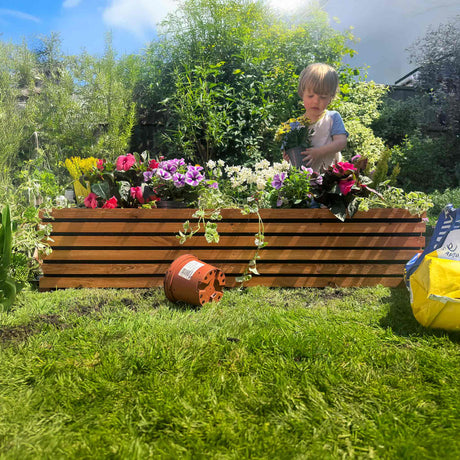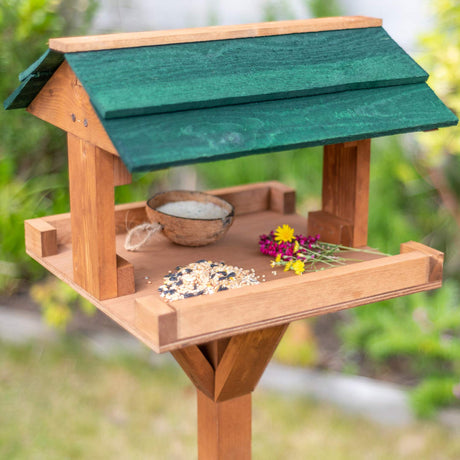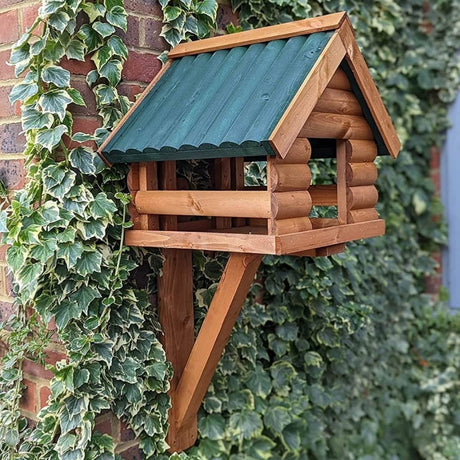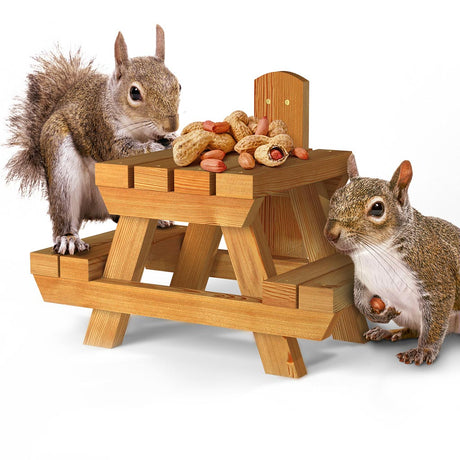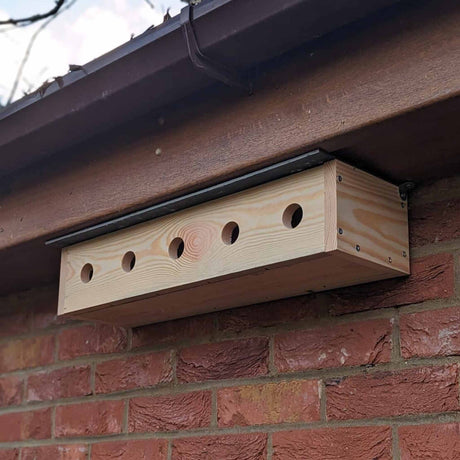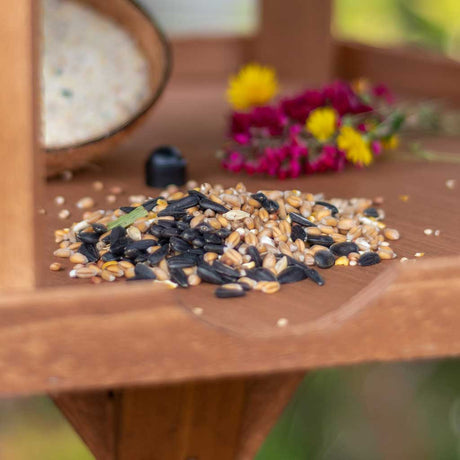There's something magical about discovering what wildlife visits your garden when you're not watching. Whether it's birds nesting in a box, hedgehogs snuffling through the undergrowth, or foxes making their nightly rounds, a wildlife camera lets you witness these secret moments up close.
But with so many options available, how do you choose the right one? In this guide, we'll walk you through everything you need to know to find the perfect wildlife camera for your garden.
Why Use a Garden Wildlife Camera?
Wildlife cameras open up a whole new world of nature observation. They allow you to:
Watch without disturbing. Animals behave naturally when they don't know they're being watched. A well-placed camera captures authentic behaviour – from the first egg laid in a nest box to hedgehogs raising their hoglets.
Never miss a moment. Unlike sitting by the window hoping to catch a glimpse, cameras record continuously or trigger on motion, so you'll see everything that happens – even at 3am.
Connect your family with nature. There's nothing quite like gathering around a screen to watch baby blue tits taking their first peek at the world. It's educational, heartwarming, and helps children (and adults!) develop a deeper appreciation for wildlife.
Become a better wildlife gardener. When you know which animals visit and when, you can provide better support – whether that's fresh water for hedgehogs or the right food for your feathered friends.
Understanding Different Types of Wildlife Cameras
Before diving into specific models, it's helpful to understand the main categories of wildlife cameras and what they're designed for.
Bird Box Cameras
These compact cameras are specifically designed to fit inside nest boxes, giving you an intimate view of nesting birds from egg to fledgling.
Best for: Watching blue tits, great tits, robins, and other garden birds raise their families. If you've ever wondered what goes on inside that little wooden box in your garden, these cameras reveal all.
Key features to look for: Wide-angle lenses to capture the entire nest area, invisible infrared night vision (so birds aren't disturbed), and a small form factor that doesn't crowd the nesting space.
Bird Feeder Cameras
Designed to point at your bird feeders or bird tables, these cameras let you identify visiting species and watch feeding behaviour throughout the day.
Best for: Bird enthusiasts who want to see which species visit their garden, observe feeding patterns, or simply enjoy watching garden birds go about their daily routines.
Key features: Weatherproof housing (as they're often mounted outdoors), good daytime colour quality, and positioning flexibility to get the perfect angle on your feeder.
Hedgehog House Cameras
Similar to bird box cameras but optimised for ground-level observation, these cameras work brilliantly in hedgehog houses or feeding stations.
Best for: Monitoring nocturnal hedgehog visitors, watching hedgehogs nest or hibernate, and understanding which individuals visit your garden regularly.
Key features: Excellent infrared night vision (hedgehogs are primarily nocturnal), wide-angle coverage for the house floor area, and positioning options for the best view.
Trail Cameras
These standalone, motion-activated cameras can be positioned anywhere in your garden to capture passing wildlife.
Best for: General wildlife watching – foxes, badgers, deer, visiting cats, or any animal that wanders through. Perfect for discovering what visits when you're asleep.
Key features: Battery operation (no cables needed), weatherproof design, motion sensors with good trigger speed, and local recording to memory cards.
Outdoor Wildlife Cameras
These weatherproof cameras can be mounted on walls, fences, or trees to monitor larger areas of your garden.
Best for: Watching bird baths, ponds, wildlife feeding stations, or general garden surveillance to see what animals pass through different areas.
Key features: Robust weatherproof casing, longer infrared range for larger spaces, and flexible mounting options.
Key Features to Consider
When choosing a wildlife camera, several technical features will affect your viewing experience. Let's break down what matters most.
Video Quality
Modern wildlife cameras typically offer either standard definition (around 700 TV lines) or Full HD 1080p.
Standard definition cameras are budget-friendly and perfectly adequate for casual viewing on a TV. You'll see what's happening clearly, but details like individual feathers won't be pin-sharp.
Full HD 1080p cameras provide crisp, detailed footage where you can see every feather, whisker, and expression. If you want to identify bird species confidently or share stunning footage, HD is worth the investment.
Some newer models even offer 4K resolution, providing exceptional clarity for those who want professional-quality wildlife footage.
Night Vision
Since much wildlife activity happens at dusk, dawn, or through the night, infrared night vision is essential.
940nm no-glow infrared is the gold standard for wildlife cameras. It's completely invisible to animals – no red glow whatsoever – so it won't disturb nesting birds or spook cautious hedgehogs.
850nm infrared is more common in trail cameras and provides slightly better range, but produces a faint red glow. Most wildlife won't be bothered, but some sensitive species might notice it.
Night vision range varies by camera. For inside nest boxes or hedgehog houses, 1-2 metres is plenty. For outdoor cameras monitoring larger areas, look for 10-20 metre range.
Connectivity Options
How you connect and view your camera significantly affects convenience and setup complexity.
WiFi cameras connect to your home wireless network and stream to your smartphone via an app. They're incredibly convenient – watch from your sofa, get motion alerts, and share footage easily. However, you'll need decent WiFi signal at the camera location.
Wired network (PoE) cameras use an Ethernet cable for both power and data. They're rock-solid reliable with no wireless dropouts, and the cable can run up to 100 metres. Perfect if you want guaranteed 24/7 streaming or have WiFi dead spots.
Cable connection (analogue) cameras plug directly into your TV using a simple video cable. No apps, no network setup – just plug in and watch. Ideal for those who prefer straightforward technology or want to watch on a big screen without smartphone involvement.
Wireless (analogue) cameras transmit to a receiver plugged into your TV using radio signals. They avoid running long cables but offer standard definition quality and can suffer interference.
Trail cameras are self-contained – they record to a memory card which you retrieve to view footage. No connectivity needed, but also no live viewing.
Power Supply
Most wildlife cameras require mains power for continuous operation, though solutions vary.
Mains-powered cameras need a power outlet nearby (or an extension cable). The advantage is 24/7 operation without worrying about batteries. The cables are typically low-voltage and thin enough to route discreetly.
Solar-powered cameras use rechargeable batteries topped up by solar panels. They're perfect for locations without power access, though they operate on motion-detection rather than continuous streaming to conserve battery.
Battery-powered trail cameras run on AA batteries for weeks or months, making them truly wireless. Perfect for temporary setups or remote locations.
Recording Capability
Some cameras record directly to memory cards, while others require external equipment.
Built-in microSD recording (available on most modern WiFi and network cameras) is incredibly convenient. The camera saves motion-triggered clips or continuous footage locally. You can review it later even if your internet was down.
Cloud recording (subscription-based) backs up footage online. Useful if you want off-site storage or worry about the camera being tampered with.
External DVR/NVR recording works with wired network cameras if you want professional-grade 24/7 recording to a dedicated device.
Analogue cameras require external recording devices if you want to save footage – otherwise they're live-view only.
Audio
Most modern digital cameras include microphones, adding a wonderful dimension to wildlife watching. Hearing baby birds cheeping or hedgehogs snuffling really brings the experience to life.
Budget analogue cameras typically lack audio, providing video-only.
Choosing the Right Camera for Your Needs
Now that you understand the options, let's match cameras to common scenarios.
Best for Bird Nest Boxes
WiFi Bird Box & Wildlife Habitat HD Camera
This is our top recommendation for watching nesting birds. It offers Full HD 1080p video with invisible infrared night vision, connects to your smartphone via WiFi, and is compact enough to fit in any standard nest box without crowding the birds.
You'll watch live from anywhere, receive motion alerts when birds visit, and record to a memory card to capture every stage from egg-laying to fledgling.
Alternative options:
- Wired Network Bird Box & Wildlife HD Camera (2nd Gen) – Choose this if WiFi signal is weak in your garden. The wired connection is ultra-reliable.
- Cable Connection Bird Box & Wildlife Camera – Perfect if you prefer watching on your TV without apps or smartphones.
Best for Bird Feeders
WiFi Bird Feeder HD Camera Pack
Specifically designed for feeder watching, this kit includes a weatherproof HD camera with a clever mounting system that positions perfectly to capture birds feeding.
Stream 1080p footage to your phone, identify species as they visit, and record your favourites. The setup is weatherproof and can handle our unpredictable British weather.
Alternative option:
- WiFi Outdoor Wildlife HD Camera – A versatile weatherproof camera that works brilliantly pointed at feeders, bird baths, or anywhere else in your garden.
Best for Hedgehog Houses
WiFi HD Hedgehog House Camera (3rd Gen)
Watching hedgehogs is utterly captivating, and this camera is purpose-built for hedgehog houses. The excellent infrared night vision captures beautiful footage of these nocturnal visitors, and the wide-angle lens ensures you see everything happening in the house.
Connect via WiFi to watch on your phone, set motion alerts to know when your prickly friend arrives, and record those special moments like hoglets being raised.
Alternative options:
- Wired Network Hedgehog Box HD Camera Pack (2nd Gen) – For reliable wired connection if WiFi doesn't reach your hedgehog house location.
- Cable Connection Hedgehog TV Camera Pack – Simple TV viewing without apps.
Best for General Garden Wildlife
OS Wild 4K WiFi Trail Camera
For capturing everything that wanders through your garden – foxes, badgers, deer, visiting cats, or unexpected visitors – a trail camera is perfect. This 4K model offers exceptional video quality, motion-activated recording, and weatherproof construction.
Battery-powered means you can position it anywhere without worrying about power cables. It records to a memory card which you review later to see what visited overnight.
Best for Remote Locations (No Power Access)
Solar Powered WiFi Bird Box HD Camera
If your nest box or wildlife watching spot is far from power outlets, solar power solves the problem. This camera runs on rechargeable batteries topped up by an included solar panel.
It offers the same WiFi connectivity and HD quality as mains-powered cameras, but operates on motion detection to conserve battery. Perfect for allotments, large gardens, or any location where running power cables isn't practical.
Also consider:
- Solar Powered WiFi Bird Box HD Camera Starter Pack – Includes a nest box with the camera, providing everything you need to start watching.
Best for Long-Distance Coverage
Long Range Wireless Network Bird Box Camera (up to 300m Range)
If your bird box or wildlife watching spot is far from your house – perhaps at the end of a large garden or on farm buildings – this long-range system transmits up to 300 metres.
It uses a powerful wireless transmitter to send the HD signal back to your router location, meaning you don't need WiFi coverage at the camera itself.
Best Budget Option
Cable Connection Bird Box & Wildlife Camera
For straightforward, affordable wildlife watching, the cable connection camera offers excellent value. Simply plug it into your TV and start watching – no apps, no network setup, no complications.
While it provides standard definition rather than HD, the image quality is perfectly adequate for enjoying wildlife, and the price point makes it accessible for beginners or those on a budget.
Installation and Setup Tips
Getting your camera positioned correctly makes all the difference to your viewing experience.
For Bird Box Cameras
Mount before nesting season. Ideally install cameras in autumn or winter when boxes are empty. Birds may be wary of changes during breeding season.
Position at the roof. Mount the camera facing downward from the inside roof of the box. This gives the best view of the nest without taking up floor space.
Check your focus. Some cameras have adjustable focus. Test before final installation to ensure the nest area is sharp.
Run cables discreetly. Thin power cables can exit through small holes or gaps in the box lid. Keep them secure and away from the entrance to avoid birds becoming tangled.
For Feeder and Outdoor Cameras
Get the height right. Position cameras at roughly the same height as the feeder or wildlife area you're monitoring.
Avoid backlighting. Don't point cameras directly toward the sun as it will wash out your image. Morning light from the side is ideal.
Check the field of view. Before securing permanently, check the camera's view using your phone or TV to ensure everything you want to see is in frame.
Secure weatherproof cameras properly. Even weatherproof models benefit from being angled slightly downward to help rain run off rather than pooling around fittings.
For Hedgehog House Cameras
Corner mounting works well. Position the camera in a top corner facing the main chamber, ensuring you can see both the entrance tunnel and sleeping area.
Protect the cable route. Ensure hedgehogs can't chew or pull cables. Route them through small gaps or cable trunking.
Test night vision first. Since hedgehogs are nocturnal, test the infrared view before finalising the setup.
WiFi Setup and Connectivity
Many customers worry about getting WiFi cameras connected, but modern models make this straightforward.
Checking Your WiFi Coverage
Before choosing a WiFi camera, check your signal strength at the proposed camera location. Simply take your phone to the spot and see if you can stream a video smoothly.
If signal is weak, consider:
- A WiFi range extender to boost coverage outdoors
- Moving your router closer to a window facing the garden
- Choosing a wired network camera instead
Connection Requirements
WiFi cameras typically need:
- 2.4GHz WiFi network (5GHz isn't always compatible)
- At least 2 Mbps upload speed for smooth streaming
- A router that allows new device connections
Initial Setup Process
Most WiFi cameras follow a similar setup:
- Power on the camera and wait for it to create its own temporary WiFi network
- Connect your phone to that network
- Use the camera's app to tell the camera your home WiFi name and password
- The camera connects to your home network
- You can now view it from anywhere via the app
Many cameras provide voice prompts to guide you through this process, and detailed instructions come in the box.
Frequently Asked Questions
Will the camera disturb the birds or wildlife?
Modern wildlife cameras are specifically designed not to disturb animals. They're small, silent, and use invisible infrared for night vision. Thousands of customers successfully watch birds nest with cameras installed, and the birds behave completely naturally. The key is installing before breeding season when possible, so birds discover the box with the camera already in place.
Do I need WiFi for a wildlife camera?
Not necessarily. WiFi cameras require your home wireless network, but we also offer cable connection cameras (plug directly to TV), wired network cameras (use Ethernet cable), and trail cameras (completely standalone with memory card recording). Choose based on your preference and setup.
How do I power a camera if my bird box is far from the house?
You have several options: run an extension cable (thin power cables can run 20+ metres), use a solar-powered camera, or choose a battery-operated trail camera. Many customers successfully route cables discreetly along fences or buried shallowly under mulch.
Can I watch on my TV instead of a smartphone?
Yes! Cable connection cameras plug directly to your TV. WiFi cameras can display on smart TVs using devices like Amazon Echo Show or by casting from your phone. Some customers use both methods – phone for convenience, TV for family viewing.
How much data does a WiFi camera use?
WiFi cameras typically use 1-3 GB per week if streaming regularly. Motion-only recording uses much less. Most UK broadband packages easily handle this, and you can reduce quality settings in the app if needed.
What happens if my WiFi goes down?
Cameras with memory card slots continue recording locally even if WiFi drops – you just can't view remotely until connection restores. When you're home on the same network, many cameras can stream directly without internet.
How long do recordings last?
This depends on your memory card size and recording settings. A 64GB card can store several weeks of motion-triggered clips or about 1-2 weeks of continuous footage before older files are automatically overwritten. You can download clips you want to keep permanently.
Making Your Choice
Choosing the right wildlife camera comes down to understanding what you want to watch and how you want to view it.
For nest box watching with modern convenience, choose a WiFi bird box camera. You'll get HD quality, smartphone viewing, and motion alerts – everything needed to follow the complete nesting story.
For reliable, simple TV viewing, cable connection cameras offer plug-and-play operation without apps or network setup.
For general garden wildlife discovery, trail cameras capture everything that passes by, day or night, without any complicated installation.
For hedgehog watching, dedicated hedgehog house cameras provide the perfect viewing angle and excellent night vision for these nocturnal visitors.
Remember, the best camera is the one that matches your technical comfort level, viewing preferences, and the wildlife you want to observe. There's no single "perfect" choice – just the perfect choice for your situation.
Getting Started with Wildlife Watching
Once you've chosen your camera, you're embarking on a wonderful journey into your garden's secret wildlife world.
You'll discover things you never knew were happening – from the incredible dedication of parent birds feeding chicks dozens of times per hour, to the surprisingly bold personality of the hedgehog who visits every Tuesday at 11pm.
These cameras don't just let you watch wildlife; they help you become a better wildlife gardener. You'll learn what your visitors need, when they're most active, and how you can support them better.
And perhaps most importantly, they create magical moments to share with family and friends – bringing nature's wonders right into your living room.
Ready to start your wildlife watching adventure? Explore our complete range of Green Feathers wildlife cameras and find the perfect match for your garden.


